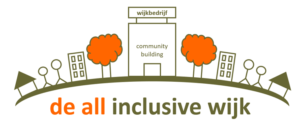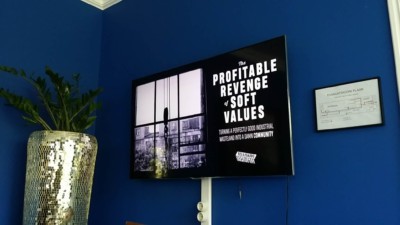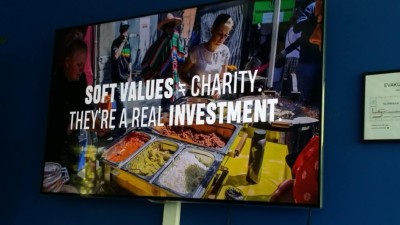Marilyn Hamilton's Blog, page 39
October 30, 2018
Allelujah Sanctuary!! From Alone with God to Together with God
I have had a daily meditation practice since 1984 when I returned to Canada from living abroad. I took the training for TM, learning that the benefits of meditation accrue after regular and extended practice.
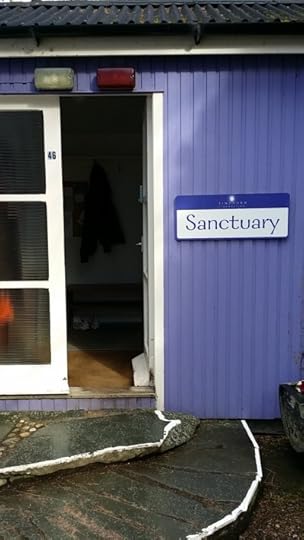
Being an Eldest Daughter, I had the quality of dedication deeply ingrained in my psyche. So, I set out to discover the difference meditation could make in myself by devoting a minimum of 20 minutes per day every day.
I lived too far away from the TM centre to journey in to join others in group meditation and I did not have local or family support for this practice. However, that did not deter me from engaging in my “experiment”. At the end of year, I noticed that had been able to build meditation into my morning cycle. I wasn’t sure I was doing it “right” – but it seemed to give me both clarity and strength. I realized mediation was becoming part of who I am.
This practice of meditation became better informed by readings and the occasional retreat. And it probably prepared me to “wake up” in 1990. Then, at a 4-day retreat, I had a satori experience (using a process designed by Ramana Maharshi) that affirmed for me the fundamental nature of consciousness and my interconnection with all Being. This opened the door of seeking more regular experiences of practising with others. Gradually my meditation shifted from an individual awareness of Divine Source to a collective awareness of Divine Source (and Re-Source).
As I became progressively in-formed by the Integral and Spiral Dynamic communities of practice, my meditation practice heightened, cleared, deepened and widened (as Sean Esborn-Hargens of MetaIntegral might frame it). I looked forward to our periodic gatherings where I could study with spiritual seekers and adepts like Ken Wilber, Roger Walsh, Terry Patten, Cindy Wigglesworth, Craig Hamilton, Diane Musho Hamilton and Bill Harris.
But I also accessed spiritual technologies like brain entrainment recordings from Holosync, Learning Strategies, iAwake and Spiritual Technologies. Most of these technologies derived from decades or centuries or millennia of collective practices learned in monasteries, ashrams and spiritual communities. So, it was ironic that all these technologies that rested on deep learning in collectives, sanghas and gatherings specifically designed to develop my heart, brain, body and soul, could be utilized by me on my own.
In February 2018, I moved to Findhorn Foundation (FF) Ecovillage, Spiritual Centre and Learning Community. For the first time in my (meditative) life I have the opportunity to meditate every day together with others in community. In FF a spiritual field has emerged out of 56 years of devotion to meditation that is not only a sitting practice, but one that connects deeply with Nature and the subtle realms. The history of collective intelligence here has manifested in revelations (recorded by co-founder, Eileen Caddy), in manifestations (literally built into the fabric of FF by Peter Caddy) and grown in relationships with the devas of plants, animals and the unseen realms (by Dorothy MacLean).
So, the community in FF is not only people who live, study and visit here, but the whole environment that has emerged as a living organism – much like what I call a human hive. And as a community with such a profoundly shared history, the collective intelligence is a palpable sense that connects earth, sky, sea, built environment and all the individuals and groups that co-exist in this place.
As I reflect on my own experience of meditating on my own over the last four decades, I am deeply grateful that every morning I can join the Taizé singing meditations, followed by a visit to Sanctuary where I join the community at 8:35 am for 20 minutes of collective togetherness with God. This practice is lead by many people from many lineages. It may open with a poem, an injunction, 3 gongs or a digeridoo. It may close with a short blessing, one chime or in blessed silence. But its value is offered to the world for the greatest good of all Being.
I look forward to other regular meditations – at the Full Moon. Weekly for the Bees (in the Nature Sanctuary). Monthly with hundred of people in the Universal Hall (connected by livestream to as many more people around the world). Daily with attunements for work and meals. When I travel, I still practise meditation on my own – but now I find that I sorely miss the meditations with others that brings us all into the Divine presence regularly at the same space/time. The “together practice” amplifies my own meditation experience, because I contribute to the experience of others as they do to me. This is one of the ways that We Space is cultivated, nurtured and joyfully shared here. I am so blessed to grow in, with and as this spiritual community in service to the greatest good of all locally and non-locally. It has taken my original experiment in meditation started in 1984 to another level of commitment that seems to directly grow the Master Code – as I meditate for myself, I create space for others to do so, and together our focus contributes to the wellbeing of our places and the evolutionary circles of compassion on our planet. Allelujah! Allelujah! Allelujah! Allelujah!
This blog series is a set of Dharma Reflections from Findhorn Foundation, Scotland.
4 Voices of Taizé: 4 Voices of Integral City
Allelujah Sanctuary!! From Alone with God to Together with God
October 29, 2018
4 Voices of Taizé: 4 Voices of Integral City
Since I have moved to Findhorn Foundation Ecovillage in February 2018, I have committed to two collective practices both of which start my day. The first starts at 8am in the Nature Sanctuary (the second practice is Sanctuary which I will write about in the next blog).
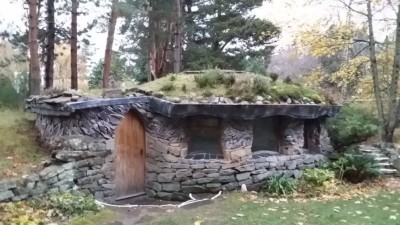
Taizé is a beautiful tradition of singing sacred songs as a shared meditation (started in an ecumenical Christian monastic fraternity in Taizé, Saône-et-Loire, Burgundy, France).
I love it because it brings the awareness of the world into our consciousness first thing everyday – as we sing in many languages. Any given morning our four songs might be sourced from Catalan, Latin, French, German, Russian, Greek, South African or Korean. Our singing chamber might hold 6 people in the dark of winter or 60 people (a record we set this August) at the height of summer courses.
Taizé songs are short, with mantra-like or chanting-style repetitions. They can be sung in unison; in rounds of 2 to 4 parts; or 2 or 4-part harmony.
The chamber is set out kiva-style with simple wooden benches (graced by jewel-coloured cushions) around the stone walls. In the centre of the slate floor sits a beautiful altar. It is made from a large granite (or marble) egg that acts as the focus of our attention. This mysterious stone is sundered in half so that the inner surfaces are polished and one half, balanced at the horizontal, holds a lighted candle surrounded by fresh flowers.
Every day we have a new leader, who selects the songs from a small library of songbooks. We enter the kiva, removing our shoes and passing from an outer (profane) chamber into the sacred space through a draped doorway. We see the voices marked out on the floor. To the left of the door are the women’s voices: Soprano, Alto. To the right sit the men’s voices: Bass, Tenor.
Our order of service starts promptly at 8am and is always the same:
Greetings and Welcome
Sing 3 OM’s to bring our voices into tune with each other and the Universe.
3 Songs
Prayer time – which may be said out loud in any language or in the silence of our hearts.
A final Song
Blessings and good wishes for the Day.
I wonder sometimes why I have become so committed to the practice? One reason might be that it is changing my brain!! As a person who could not carry a tune nor even remember one, I find that the melodies and words, so often repeated, now arise unbidden at any time of day – as inspirations, comforts, and reminders that the Divine is with us always.
If it were only the positive engagement with the music I would be a willing participant in this experiment of Integral mystery. For it involves the 4 Quadrants of the Spirit, the Body, the Community and the Intersection of Space/Time. It unites the linguistic voices of I/individual singer, WE/self-selecting choir, IT/song book/composition, and ITS/resonant process and place.
But Taizé, with its 4 voices, also reflects (for me) the 4 Voices of the City. It symbolically gathers the Citizens, the Civic Managers, the Innovators and the Civil Society into the same space for a short period of time. We become the harmony of the human hive. In so doing, it co-creates community with a practice that is satisfying Aesthetically, Performatively, Relationally and Systemically. As such, Taizé brings many rewards to me for rising with the dawn and joyfully celebrating Life with whoever is called to share 20 sweet minutes.
Taizé is a practice that strengthens the 4 Voices of the Integral City every day the field of music arises here and elsewhere around the world. From the harmony of the 4 Voices, a kind of Grace descends over us that unites us in a profound sense of Oneness. It musically reminds me of the path we seek to become Gaia’s Reflective Organs. For that I am deeply grateful.
This blog series is a set of Dharma Reflections from Findhorn Foundation, Scotland.
September 18, 2018
Integral City Reflective Organ – September Equinox 2018: Wholing, Including, Emerging, Evolving

This newsletter is published quarterly using a cycle of perspectives on the Integral City viewed from: Planet, People, Place and Power. The theme of this issue is Place.
It should be noted that, at the same time as this [Integral City 4 quadrant] framework has evolved, a number of other city specialists have focused on “Place” in a wholistic way. Some may object to my parsing apart Place Caring from Place Making. But I have found that people only care to make what they have capacity to care about. Ironically, in this intensely ever-connecting world (re)learning to care is a basic building block for all 4 Voices to cogenerate well-being in the making of place and all of the city’s systems and subsystems.
Hamilton, M. (2017). Integral City Inquiry & Action: Designing Impact for the Human Hive. Tucson, AZ: Integral Publishers, p. xxvii
—
Scroll to the end to access Free Resources.
Wholeness Emerging in the Human Hive
Wholeness in the Human Hive seems to be emerging as a powerful – and perhaps unexpected outcome of the pressures, denials and affronts that cities face from senior levels of government.
When the federal government of any country downloads onto cities the expectations that cities solve the social dilemmas that federal legislation has created without providing commensurate funding to solve the problems (e.g. substance addiction response policies), they risk experiencing the wholeness that can arise when anger is sparked. When federal departments refuse to accept scientific research substantiating climate change, they risk the rebellion of city residents who will bear most of the critical losses. When senior governments insult the elected officials of cities by neglecting to consult them on key issues, they encourage the widespread passive aggression of citizen disengagement that can result from disrespect and distrust.
As a radical optimist, I am always inclined to respond to the re-framing of city potential in the context of whatever life conditions the city faces. I propose this can happen through the re-imagining of Placecaring as the citizen’s core experience. This in turn can result in the renewed relationship of citizens to Place Making. I see this dual approach as similar to what Margaret Wheatley calls for, when she seeks Warriors of the Spirit – where Placecarers wield the Sword of Compassion and Placemakers wield the Sword of Wisdom. Working together they give Wise City Warriors a strategy for wholeness.

Art by Gaia Orion www.GaiaOrion.com
I fully appreciate how Ian Wight and Mark DeKay have explored place, Place, PLACE from intimate and advanced integral perspectives revealing Modern, Post-Modern and Integral definitions. Wight says: “consider a place/Place/PLACE differentiation similar to [DeKay’s] nature/Nature/NATURE elucidation. Move beyond locating ‘place’ in just the physiosphere and/or the biosphere. Locate ‘Place’ as – additionally – in the noosphere. Think of PLACE as all quadrants, all levels (including the theosphere? (see p. 327 in DeKay’s Integral Sustainable Design). Similarly, why not situate/differentiate your Integral sense of city/City/CITY for even greater, more expansive, notions of wholeness. In that way, city/City/CITY wholeness in the case of Integral City will more closely align with the whole-making, at the core of both placemaking and well-being for myself. This might well be the terrain around which we both could eventually find common ground.”
Cities evolve through a cosmology of elements converging and reforming themselves (as Beth Sanders acknowledges in her article below on Edmonton’s evolution). Cities emerge through progressive levels of complexity that build on the layers of people aligning around homes and hearths; then through organizations and communities; and finally, through economies and governance.
Each of these levels of complexity can be mapped in terms of Quadrants and Levels (Integral City Map 1). In addition, these levels of complexity can be nested into Holarchies of engagement and belonging (Integral City Map 2).
Each of these maps (plus Maps 3, 4 and 5 ) reveal realities in the city that are co-existing and co-arising. Thus, each scale and aspect have potential for change. This potential can be nurtured through our commitment to wake up, grow up, whole up and clean up. Thus, facilitators, guides and teachers are needed at each level of city system and sub-system to reinvent the capacity at each level and thereby encourage the evolution of the whole city.
We can recognize that each level is holarchic – containing and/or mirroring in some way all the other levels (e.g. community can’t exist without citizens; citizens exist in some aspect of community). Each is also fractal – reflecting the self-same patterns in other levels (e.g. individuals, groups and organizations develop through ego, ethno, world, Kosmic-centric capacities).
When we are imagining how to expand or deepen the wholeness of the city, we are called to honour and support the pioneers who are reinventing individuals, groups, organizations, communities and sectors in the city. The way that we hold these sets of wholeness in the Human Hive is to invoke the Master Code. We remember the CARES – of caring for Self, Groups/Organizations, Places and Planet. For the first time in history our cities are learning from the bottoms, tops and middles how to placemake and become Gaia’s Reflective Organs.
All of us who are working across these terrains, sharing this common ground of Placecaring and Placemaking are celebrated in this newsletter. Transitiereizen tells us about Placecaring and Placemaking of the All-Inclusive Neighborhood. Then we look at the growing methodologies of Placemaking explored by Paul van Schaik in his new Hub 11 on Emergence. And finally, we consider the evolution of PLACE through Beth Sanders’ Integral City approach to engaging the 4 Voices for the renewal of mature neighborhoods in the city. Finally, we offer other resources that expand our sense of wholeness in governance, economics and ecology at the global scale (Terry Patten) and the local scale (Rick Smyre).
Wholing the Human Hive is an AQAL endeavour, calling forth our attentions and intentions to nurture the development of all Quadrants, Levels, Lines/Intelligences and Types in the city every day.
The All-Inclusive Neighborhood
Patricia van der Haak and Carla Onderdelinden, Co-Founders of Transitiereizen, The Netherlands have developed an Integral-holistic approach for transforming communities that face many “wicked” challenges into sustainable communities. In this article they start by considering how to organize abundance and sustainability.
You probably know the concept of the all-inclusive holiday with as much food, sunshine, and swimming as you wish? The impact of the all-inclusive neighborhood is the same: how much healthy food, work, leisure, happiness, labour, care or energy do you wish? It is all possible when you decide to work together and purchase and act as a collective.
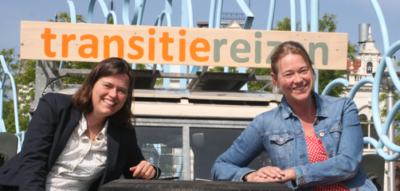
Doing so, gives a whole new spectrum of:
urban business models: citizen to citizen, business to community, community to business, community to government, government to community.
integral-holistic organs and infrastructure in a neighborhood: like social purchase companies, social networks, social enterprises, social big data / algorithms. As we suggest below: these organs and infrastructure work like the lungs and veins of a community (to the interest of all).
The all-inclusive neighborhood (in Dutch: de all-inclusive wijk)
This is a community-based business model and a method to realize socio-economic transformation in communities like a neighborhood, a village or a city. The model shows how a neighborhood can work as a collective, using community owned structures to organize daily life. This way of working together opens new opportunities for community entrepreneurship, socio-economic transformation and the introduction of MVC (multiple value creation) business models.
How does it work? Find out the answer and read the whole article here.
 Edmonton is Evolving
Edmonton is EvolvingBeth Sanders MCP RPP, Founder of Populus and Meshworker of the Year 2013, Leader in Integral City Core Team and Global Constellation, asks: How do we welcome more people and new homes in our older neighborhoods? This is the question behind a project in Edmonton, Canada, to develop an action plan for city government to support the city’s efforts to grow “up” instead of “out”, to make the city more densely populated and be more fiscally and ecologically responsible. …
With [the] latest wave of infill, [Edmonton] city government chose to involve the wider city system to ask what action it should take.
Over 20 months, conversations took place among and between citizens, civic managers, community organizations and the business community. The first round of conversations revealed desired outcomes and possible actions to make those actions a reality. The second round involved identifying the actions that made sense—from the perspective of citizens, civic government, community organizations and the business community—then fine-tuning them. Along the way, a document grew with the project, revealing the city systems and what they had to say (What We Heard).
… The conversations began with processes to hear each Integral City voice specifically, then process to find the actions while integrating the perspectives. Citizens, community organizations, city hall and the business community could see what each other was looking for – and what city government was committed to do (and not do). …
A solid, responsive action plan is now being implemented that will change, once again, this place. This time with more consciousness from a wider range of the systems of the city.
 Urban Hubs Emerging
Urban Hubs Emerging Paul van Schaik, continues the publication of his graphic book series with Urban Hub 11: Co-Creating Emergence. Just one example of the many authors, designers, and architects who are practising emergent designs whom he highlights in this book is Steffen Lehmann.
Steffen is quoted from his new book: Urban regeneration: a manifesto for transforming UK cities. This book provides an urban manifesto and clear guidance to city councils, architects, planners and decision makers on how to maximize social and environmental benefits from the urban regeneration of UK cities. It explores and offers guidance on the complex process of how to transform cities… [with] a 21st-century manifesto of ten urban … focusing on the characteristics of a ‘good place’ and the strategies of sustainable urbanism. The Urban Manifesto builds on … 30 years of reflective practice in urban design and sustainable architecture, and extensive advisory work with cities worldwide, [ advocating] health and well-being as the main policy drivers… This Urban Manifesto frames an architecture of re-use that translates and combines the complex ‘science of cities’ and the art of urban and architectural design into actionable and practical guidance on how to regenerate cities. Fascinated by the typology and value of the compact UK and European city model, Lehmann introduces the concept of ‘high density without high buildings’ as a solution that will make our cities compact, walkable, mixed-use and vibrant again. This book was written to fill a much-needed gap and offer guidance on the complex process of how to transform and regenerate existing post- industrial cities in the UK, where attention is turning to the regional cities. It is an important resource for practicing architects (and students), town planners, urban designers, urban decision-makers, geographers and engineers taking an active role in developing urban strategies and adaptation solutions to ensure our cities are resilient, resource-efficient and sustainable in the face of intensifying global warming. He offers the examples of green space in central Rotterdam. He points to a worldwide trend that universities develop their city campuses and open them up as informal green spaces to the surrounding city, with strong patronage for good architecture. He favours the model of the poly- centric network city, for example, Brighton & Hove who are developing higher-density areas around railway stations.

In Hub 11, van Schaik notes that the key to an Integral urban design approach is the notion that although other aspects of urban life are important, people (sentient beings), as individuals and communities, are the primary ‘purpose’ for making cities thriveable. All other aspects (technology, transport & infra-structure, health, education, sustain-ability, economic development, etc.) although playing a major part, are secondary.
The Urban Hub Series applies Integral theory or an Integral Meta-framework in understanding cities and urban Thriveability. Although each book can stand alone, taken together they give a more rounded appreciation of how this broader framework can help in the analysis and design of thriveable urban environments.
How to access the Urban Hub Series: Pdf versions are free to view or download by clicking here. They can also be viewed at issuu.com/paulvanschaik .Hardcopies can be purchased from Amazon.
What’s Really Happening in This Crazy World and How You Can Be the Change You Want to See
Integral City joined Terry Patten for the launch of his book A New Republic of the Heart. We think this is one of the best summaries for cities to grasp the VUCA context in which they are living today: volatile, uncertain, complex and ambiguous. Listen to Terry Patten speak frankly about the complex existential dynamics, emotional understandings, social commentary and embodied awakened consciousness that are synthesized in his best-selling book, A New Republic of the Heart: An Ethos for Revolutionaries. You can access the link and download the recording here.

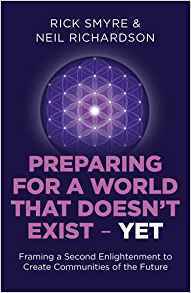

Preparing for a World That Doesn’t Exist …. Yet
In his popular book Preparing for a World That Doesn’t Exist …. Yet , author Rick Smyre (founder of Communities of the Future (COTF)) looks at community through reconceptualizing key institutions in ways that they can work together to seed transformational ideas to imagine a whole new future. Smyre identifies ideas like:
Master Capacity Builders (to prepare leaders)
Future Forward College (for individuals and institutions to learn and incorporate futures thinking)
Polycentric Democracy (to expand the model for governance); and
Creative Molecular Economy (to reinvent the economic cycle and participants).
He remarks that the essence of “reciprocal learning” enables participants in a shared community learning experience to amplify their different capacities and expand their different take-aways. Further amplification comes because each person’s identity “will come from a composite mosaic of connections with different people and different efforts both locally and different parts of the world as they collaborate to create a vital and sustainable culture.”
It is clear that Rick Smyre and COTF are contributing to the emergence of wholeness in communities as he reaches out to co-create the conditions of the 2nd Enlightenment. Not surprisingly he has been influenced by many of the Scottish philosophers and sociologists who inspired the 1st Enlightenment. One of them, Patrick Geddes coined the phrase (and mental model) “Think Global, Act Local”. Many in the Integral movement (including Integral City) consider Geddes to be an early Integral Thinker. (Check out Eisenman’s and Murray’s article An Integral Lens on Patrick Geddes).
Mark These 2019 Dates for Integral City Trainings, Presentations
1. Findhorn, Scotland, April 27-30, 2019 Beyond Smart: Integral City Practices, Tools & Maps
This 2-day course introduces “practitioners” to just the basics of the Integral City model. You will learn the framework of practices, tools and maps that reveal the common patterns that impact the lives of individuals, organizations and communities within your city. This short course explores three powerful images animating Integral City systems – the integral map, the meshwork and the human hive. You will learn from your own situations and each other how the toolkit guides you beyond models for Urban Ecovillages and Traditional, Smart and Resilient Cities. For pre-registration email info@integralcity.com
2. Findhorn, Scotland, May 1-4, 2019 Beyond Resilient: Integral City Inquiry Action & Impact
This 4-day course is for “catalysts” to explore inquiry and action that inspires productive impact for reinventing today’s cities for the future. You will interact with the 4+1 Voices of the Integral City (Business, Local Government, Civil Society and Citizens, plus actors from other regional cities) to identify strategic possibilities. Integral City introduces you to new ways to think about, act in, relate to and reinvent the city as a Human Hive. Through placecaring and placemaking, we invite you to discover the unique contributions you make to its aliveness. We believe the future of cities will emerge not just from the bottom up through Smart City Technology or the top down through Resilient approaches – but from the integrated actions of the 4+1 Voices in all the cities in your eco-region, as you reinvent your Human Hives. For pre-registration email info@integralcity.com
3. Findhorn, Scotland, Sept. 14-18, 2019 Beyond Complexity: Integral City Integral City Care Context & Capacity
This 4-day course is for “meshworkers” to imagine how to reframe simplicity on the other side of complexity in the Integral City – or Human Hive. You will join graduates of prior training to build on the Integral City practitioner and catalyst competencies to apply new skills to a live case study. You will look at the city through the lenses of Care, Contexting and Capacity Building. You will view the city as a complex, adaptive living innovation eco-system, where the internal and external connections amongst the 4+1 voices of the city (Citizens, Civil Society, City/Institutional Managers, Business/Innovators (and other cities) enable conditions for thriving today. You will seek to align intra-city and inter-regional collaborations through caring for people, contexting for place and capacity building for purpose. This course introduces the practices of “meshworking”, so that practitioners who work with individual organizations and catalysts who build bridges between organizations can engage with the city as a whole. For pre-registration email info@integralcity.com
Findhorn, Scotland, April 20-16, 2019 Climate Change & Consciousness CCC2019
CCC2019 will be a participatory investigation into how we can steward a sustainable future on a radically changed planet Earth: how we will survive and how we can thrive! The conference will bring together eminent scientists, indigenous elders, business leaders, activists, youth and others to envision and begin to inhabit our joint future. It will be an international, inter-generational and multi-disciplinary gathering. Integral City is part of the Volunteer Support Team. Join us and bring your integrally-informed consciousness to make a difference. For more information on attendance click here or email CCC19@findhorn.org
Vancouver, Canada October 7-11, 2019 Ecocity World Summit
Join Integral City at the Ecocity World Summit will take place from October 7-11, 2019 with the first two days dedicated to workshops and academic sessions. The following three days, which comprise the main conference program, will engage the conference theme of Socially Just and Ecologically Sustainable Cities.
The main program will focus on sub-themes Climate Action, Circular Economy and Informal Solutions for Sustainable Development. These topics represent some of the most challenging and exciting issues in sustainability around the world and encourage international collaboration and solutions. The International Ecocity Standards (IES) will provide a framework for these discussions, exploring Urban Design, Bio-Geo-Physical Conditions, Socio-Cultural Features and Ecological Imperatives with its 18 standards.
Integral City will be bringing presentations,keynotes and workshops, that resonate with the themes and address how the Integral City frameworks enable the interaction and interplay between these topics. We would love to see you there. For information and registration click here.
Celebrating Place in the Planet-of-Cities in the Coming Quarter of 2018
September 21 marks the start of what Integral City calls the Place Quarter (from September 21 to December 20). What are emerging changes that you notice in your place? How do you relate to place/Place/PLACE? Where is Wholeness arising despite conflict and diversity? Do you care deeply for your place/Place/PLACE? And how do you express that care? Visit us on the our Integral City Website and Blog or post a comment about places that are evolving, changing, and becoming more sustainable on our Facebook page.
Meshful Blessings for our Planet of Cities from
Marilyn Hamilton and the Integral City Constellation Corps Team
PS Here are some FREE resources for evolving our Places:
Paul van Schaik – new book Hub 11: Co-Creating Emergence
Tamarack “Planning an Evaluation of Systems Change”, a webinar in the 2018 Community Change Festival series, by Meg Hargreaves and Mark Cabaj. They discuss the foundation, ideas, and steps required to properly evaluate the systems changes that emerge when tackling a complex issue. The recording of the session is available online. You can also download the presentation slides.
Take your learning further:
Read Meg’s publication Evaluating Systems Change: A Planning Guide
View Tamarack’s page on Systems Change Evaluation
Visit Meg Hargreaves’ NORC expert pagefor more resources and links
Blogs
Edmonton is Evolving
The All-Inclusive Neighborhood
Interview with Marilyn Hamilton by Alain Gauthier
Sharing the Roots of Integral City (Interview Part 1)
Sustaining Improving Evolving Propagating Integral Cities (Interview Part 2)
Estonia
Integral City Talks on IDA Radio, Tallinn Estonia
Tallinn’s Telliskivi “Creative City” Most Popular Uber Destination
Ecovillages
Ecovillage Youth & Elders Explore 6 Questions
Imagining Integral City Contributions to Designing Urban Ecovillages
Witnessing 4 Dimensions of an Ecovillage
Transition from Green to Yellow (by Leida Schuringa)
The Transition from Green to Yellow: How Can We Make It Happen?
Characteristics of the Integral/Yellow/Teal Perspective
How Can We See the Green to Yellow Transition Happening in Individuals & Groups?
Characteristics of an Integral (Yellow/Teal) Project
How Can We See the Green to Yellow Transition Happening in (parts of) Society?
September 15, 2018
Edmonton is Evolving
This blog is contributed by Beth Sanders MCP RPP, Founder of Populus and Meshworker of the Year 2013, Leader in Integral City Core Team and Global Constellation.
How do we welcome more people and new homes in our older neighborhoods? This is the question behind a project in Edmonton, Canada, to develop an action plan for city government to support the city’s efforts to grow “up” instead of “out”, to make the city more densely populated and be more fiscally and ecologically responsible.
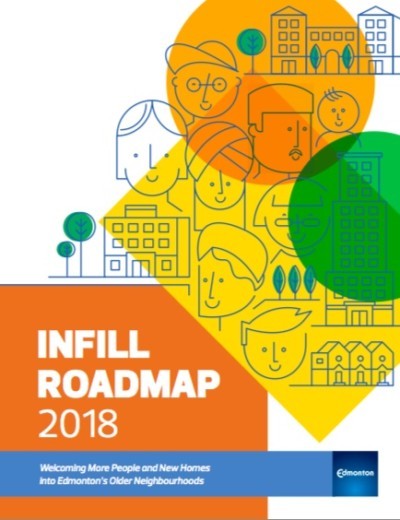
While research was done to see where people wanted to live, the kind of housing they wanted and what they wanted to spend (the housing market and affordability study), and the tools available to city government (municipal tools review) a particular challenge of the project was engaging Edmontonians—as representatives of the full city system—in a conversation about sharing their place with additional neighbors and the role of city government.
Neighborhoods evolve and shift and change with the times, always accommodating newcomers. The story of housing at this place now called Edmonton, starts with the portable homes of the Plains Cree and Blackfoot, the people indigenous to this place, and the waves of colonial arrivals in the form of immigrants many generations ago and now. And with these waves of arrival, and the changing times, the physical form of Edmonton changes shape. For the first time, the evolution of Edmonton’s neighborhoods was made explicit (Edmonton’s Urban Neighborhood Evolution). Edmonton’s neighborhoods have always been experiencing infill.
With this latest wave of infill, city government chose to involve the wider city system to ask what action it should take.
Over 20 months, conversations took place among and between citizens, civic managers, community organizations and the business community. The first round of conversations revealed desired outcomes and possible actions to make those actions a reality. The second round involved identifying the actions that made sense—from the perspective of citizens, civic government, community organizations and the business community—then fine-tuning them. Along the way, a document grew with the project, revealing the city systems and what they had to say (What We Heard).
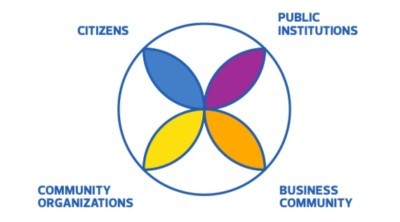
The conversations began with processes to hear each Integral City voice specifically, then process to find the actions while integrating the perspectives. Citizens, community organizations, city hall and the business community could see what each other was looking for – and what city government was committed to do (and not do).
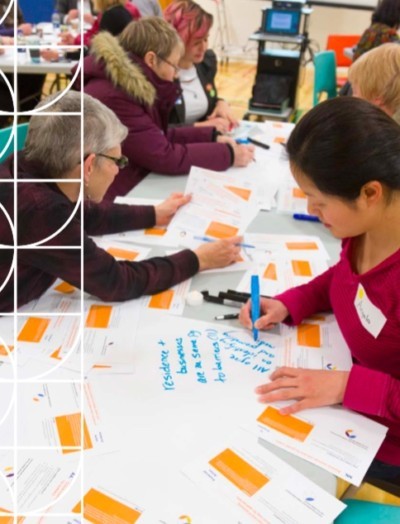
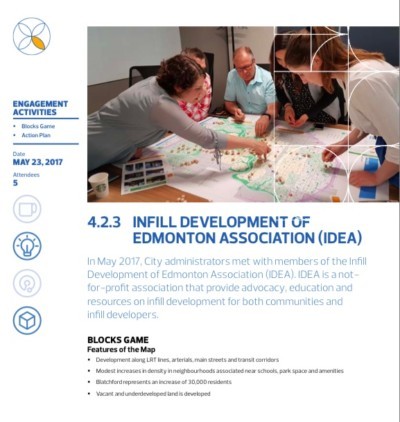
And when the action plan made its way to Council, the four voices appeared to speak to the process and the product. A sampling of what they said:
Citizens: I went to many stages of the process. Ideas, themes, and ideas at each stage. It was valuable for Edmontonians to share information with each other. I learned from Edmontonians and planners themselves, and therefore I gave informed information.
Development community: Thanks for the quality and depth of these reports. Thanks for the diversity of actions, a wide range of steps that will move our city building efforts forward.
Civic managers (Council): This is a significant body of work, and its implementation will transform the city significantly. This makes our city more inclusive by making our city more inclusive.
Community organizations: The process was welcoming, inclusive and allowed us to learn from others’ perspectives. The range of methods used generated positive commentary that was used. The time, money and energy spent on this was worthwhile.
A solid, responsive action plan is now being implemented that will change, once again, this place. This time with more consciousness from a wider range of the systems of the city.
Reading materials
Five documents are available on the City of Edmonton Website for your perusal:
Infill Roadmap 2018 documents the 25 actions to which Edmonton’s city government is committed, including a description of the action, and outcomes.
Evolving Infill: What We Heard describes the engagement process and what the Integral City voices had to say about infill.
Evolving Infill: Edmonton’s Urban Neighborhood Evolution describes the evolutionary story of settlement in Edmonton.
Evolving Infill: Municipal Tools Review lays out the range of tools available to city government.
Evolving Infill: Market Housing and Affordability Study conveys the market conditions and infill development trends.

This blog is contributed by Beth Sanders. She is a fourth-generation settler in Treaty 6 territory in Canada, a resident of Amiskwacîwâskahikan (Edmonton). She is a professional planner and president of POPULUS Community Planning Inc., one of the lead consulting firms that worked with the City of Edmonton to create Infill Roadmap 2018. Beth is a leader in the Integral City Core Team and Constellation.
September 9, 2018
The All-Inclusive Neighborhood
This is an introduction to an integral-holistic approach for transformation to sustainable communities by Patricia van der Haak and Carla Onderdelinden, Co-Founders of Transitiereizen, The Netherlands.
 Organizing abundance and sustainability
Organizing abundance and sustainabilityYou probably know the concept of the all inclusive holiday with as much food, sunshine, and swimming as you wish? The impact of the all inclusive neighborhood is the same: how much healthy food, work, leisure, happiness, labour, care or energy do you wish? It is all possible when you decide to work toghether and purchase and act as a collective.
Doing so, gives a whole new spectrum of:
urban business models: citizen to citizen, business to community, community to business, community to government, government to community.
integral-holistic organs and infrastructure in a neighborhood: like social purchase companies, social networks, social enterprises, social big data / algorithms. As we suggest below: these organs and infrastructure work like the lungs and veins of a community (to the interest of all).
The all-inclusive neigborhood (in Dutch: de all inclusive wijk)
This is a community based business model and a method to realize socio-economic transformation in communities like a neighborhood, a village or a city. The model shows how a neighborhood can work as a collective, using community owned structures to organize daily life. This way of working together opens new opportunities for community entrepreneurship, socio-economic transformation and the introduction of MVC (multiple value creation) business models.
How does it work?
Seeing a neighborhood as a whole, as a body or one household (instead of a number of separated, family-based households), with an infrastructure that facilitates food, healthcare, work, energy, maintenance and more to the benefit of all, it becomes possible to start organizing a sustainable, circular and inclusive neighborhood.
At this moment, communities aren’t organized very efficiently:
every household organizes all aspects of daily life themselves. For instance their own food, their own house, their own insurance, car, furniture, maintenance, etc. A neighborhood has none of its own organs and none of its own infrastructure to attract or produce what it needs for its own good (it has public infrastructure, like roads of shopping malls but they are owned by government or companies and not by the community as a whole).
From the point of view of an organism this is strange. Imagine that your body had no lungs or veins to bring oxygen to your cells and every cell had to move towards your skin all the time to get some air. That would be an impossible or at least very inefficient and busy way of life (for your fragmented self: the community of cells). But that’s what we do in our daily life in our communities and that is why you meet your neighbors at the check out point of your supermarket and not at home. This makes the costs of our metabolism unnecessarily high. This is profitable for your supermarket, insurance company, internet provider and so on, but it doesn’t serve the community as a whole.
Every community has its own specific, beautiful and valuable forms of capital: social capital, physical capital, ecological capital, economic capital, human capital, cultural capital. Much of it stays unused because it doesn’t fit into the system. For instance, using the talent and knowledge of elderly people or an empty building or the fruits and nuts in a local forest. Or in the city of Arnhem (neighborhood Spijkerkwartier): where citizens want to grow mushrooms on the waste product of the coffee machines from the local cafes. They can’t get a permit to do this because it is not allowed in the Netherlands to produce food with garbage. And the waste product of coffee machines is labelled as garbage, so it can’t become soil for growing mushrooms.
Not using what is available, and making what you can make yourself as a community instead of buying your needs from elsewhere, costs a lot of money. This forces people to work outside their community just to make money to buy mushrooms at the supermarket. At Transitiereizen we think this is not efficient and not sustainable.
The concept of the all inclusive neighborhood tries to transform these kinds of inefficiencies. In such a neighborhood, unused capacity (like talent or assets) gets activated, exporting of talent and assets to outside the system gets contained and a huge amount of money, materials, energy and CO2, can be saved due to much more efficient local organization. Also, when it start acting as a whole (more or less like a company or a living organism) it becomes possible for a community to give assignments to local government to really integrate and work together as partners on social, economic or ecological wicked issues, such as transformation to sustainable houses, energy, environment, food, welfare and more.

The concept of the all-inclusive neighborhood has already been introduced in several cities / neighborhoods in the Netherlands, such as Nijmegen, Arnhem, Wageningen, Zutphen and Zwolle.
In this article we’d like to introduce and reveal this new infrastructure and urban business model through exploring two of our projects: Wageningen and Arnhem.
Project – Wageningen, The Netherlands
Most households in The Netherlands heat their houses and cook their meals on natural gas. But the gas extraction in the northern part of The Netherlands will stop within a few years: it is causing more and more earthquakes. This makes national, regional and local governments ambitious to transform the natual gas system to a decentralized, sustainable energy system. In pursuit of this objective, the local government of the city of Wageningen asks: can we link the disconnecting of the natural gas network with the realization of social goals that residents consider important and other work that has to be done in this area?
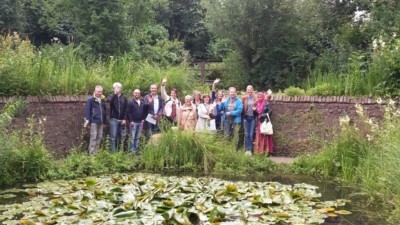
Team Wageningen (citizens, local government, civil servants, business innovators) visiting Arnhem, summer 2018.
“The Hood” or “De Nude”[1] neighborhood in Wageningen is labeled as an innovative ”district of the future ”: one of the first neighborhoods in the Netherlands that wants to disconnect from the natural gas network and transform the energy system. It is also a neighborhood where major maintenance is necessary: houses, sewage system, public green areas and pavement need to be renovated and renewed. By looking not only at the energy proposition but also at this public maintenance assignment and the social community goals of the citizens themselves, we helped them to develop an integrated vision for this neighborhood. This vision is a basis for an integrated value case and co-creation process for the development of this neighborhood for the years ahead.
[1] In Dutch Nude is just a ordinary name for a neighborhood, you say Nuu-the 
The All Inclusive Neighborhood
This is an introduction to an integral-holistic approach for transformation to sustainable communities by Patricia van der Haak and Carla Onderdelinden, Co-Founders of Transitiereizen, The Netherlands.
 Organizing abundance and sustainability
Organizing abundance and sustainabilityYou probably know the concept of the all inclusive holiday with as much food, sunshine, and swimming as you wish? The impact of the all inclusive neighborhood is the same: how much healthy food, work, leisure, happiness, labour, care or energy do you wish? It is all possible when you decide to work toghether and purchase and act as a collective.
Doing so, gives a whole new spectrum of:
urban business models: citizen to citizen, business to community, community to business, community to government, government to community.
integral-holistic organs and infrastructure in a neighborhood: like social purchase companies, social networks, social enterprises, social big data / algorithms. As we suggest below: these organs and infrastructure work like the lungs and veins of a community (to the interest of all).
The all inclusive neigborhood (in Dutch: de all inclusive wijk)
This is a community based business model and a method to realize socio-economic transformation in communities like a neighborhood, a village or a city. The model shows how a neighborhood can work as a collective, using community owned structures to organize daily life. This way of working together opens new opportunities for community entrepreneurship, socio-economic transformation and the introduction of MVC (multiple value creation) business models.
How does it work?
Seeing a neighborhood as a whole, as a body or one household (instead of a number of separated, family-based households), with an infrastructure that facilitates food, healthcare, work, energy, maintenance and more to the benefit of all, it becomes possible to start organizing a sustainable, circular and inclusive neighborhood.
At this moment, communities aren’t organized very efficiently:
every household organizes all aspects of daily life themselves. For instance their own food, their own house, their own insurance, car, furniture, maintenance, etc. A neighborhood has none of its own organs and none of its own infrastructure to attract or produce what it needs for its own good (it has public infrastructure, like roads of shopping malls but they are owned by government or companies and not by the community as a whole).
From the point of view of an organism this is strange. Imagine that your body had no lungs or veins to bring oxygen to your cells and every cell had to move towards your skin all the time to get some air. That would be an impossible or at least very inefficient and busy way of life (for your fragmented self: the community of cells). But that’s what we do in our daily life in our communities and that is why you meet your neighbors at the check out point of your supermarket and not at home. This makes the costs of our metabolism unnecessarily high. This is profitable for your supermarket, insurance company, internet provider and so on, but it doesn’t serve the community as a whole.
Every community has its own specific, beautiful and valuable forms of capital: social capital, physical capital, ecological capital, economic capital, human capital, cultural capital. Much of it stays unused because it doesn’t fit into the system. For instance, using the talent and knowledge of elderly people or an empty building or the fruits and nuts in a local forest. Or in the city of Arnhem (neighborhood Spijkerkwartier): where citizens want to grow mushrooms on the waste product of the coffee machines from the local cafes. They can’t get a permit to do this because it is not allowed in the Netherlands to produce food with garbage. And the waste product of coffee machines is labelled as garbage, so it can’t become soil for growing mushrooms.
Not using what is available, and making what you can make yourself as a community instead of buying your needs from elsewhere, costs a lot of money. This forces people to work outside their community just to make money to buy mushrooms at the supermarket. At Transitiereizen we think this is not efficient and not sustainable.
The concept of the all inclusive neighborhood tries to transform these kinds of inefficiencies. In such a neighborhood, unused capacity (like talent or assets) gets activated, exporting of talent and assets to outside the system gets contained and a huge amount of money, materials, energy and CO2, can be saved due to much more efficient local organization. Also, when it start acting as a whole (more or less like a company or a living organism) it becomes possible for a community to give assignments to local government to really integrate and work together as partners on social, economic or ecological wicked issues, such as transformation to sustainable houses, energy, environment, food, welfare and more.

The concept of the all inclusive neighborhood has already been introduced in several cities / neighborhoods in the Netherlands, such as Nijmegen, Arnhem, Wageningen, Zutphen and Zwolle.
In this article we’d like to introduce and reveal this new infrastructure and urban business model through exploring two of our projects: Wageningen and Arnhem.
Project – Wageningen, The Netherlands
Most households in The Netherlands heat their houses and cook their meals on natural gas. But the gas extraction in the northern part of The Netherlands will stop within a few years: it is causing more and more earthquakes. This makes national, regional and local governments ambitious to transform the natual gas system to a decentralized, sustainable energy system. In pursuit of this objective, the local government of the city of Wageningen asks: can we link the disconnecting of the natural gas network with the realization of social goals that residents consider important and other work that has to be done in this area?

Team Wageningen (citizens, local government, civil servants, business innovators) visiting Arnhem, summer 2018.
“The Hood” or “De Nude”[1] neighborhood in Wageningen is labeled as an innovative ”district of the future ”: one of the first neighborhoods in the Netherlands that wants to disconnect from the natural gas network and transform the energy system. It is also a neighborhood where major maintenance is necessary: houses, sewage system, public green areas and pavement need to be renovated and renewed. By looking not only at the energy proposition but also at this public maintenance assignment and the social community goals of the citizens themselves, we helped them to develop an integrated vision for this neighborhood. This vision is a basis for an integrated value case and co-creation process for the development of this neighborhood for the years ahead.
[1] In Dutch Nude is just a ordinary name for a neighborhood, you say Nuu-the 
August 18, 2018
Sustaining, Improving, Evolving, Propagating Integral Cities
This is Part 2 of a 2-part interview by Alain Gauthier with Marilyn Hamilton, Founder of Integral City Meshworks.

AG: In what ways has the Integral City work become self-sustaining, self-improving, self-evolving and self-propagating?
MH: I would say the work has become self-sustaining because it seems to have captured the many but partial truths that characterize the city. The Integral City Framework has translated into some simple tools (like the 5 maps); the Master Code (caring for self/others/place/planet at all scales); the 4+1 Voices; and the evolutionary Spirit that has been affirmed as we have explored the invisible energies of the city.
In the beginning, I realized how different the Integral City paradigm was for the city than the Traditional view of the city (bricks and mortar of built city). But I didn’t realize that it was a much more comprehensive view of the city than the most popular “advanced” perspectives – namely, the Smart City (arising from technology) and the Resilient City (reflecting environmental/systems concerns).
The Integral City rests on a worldview that assumes Consciousness (the subjective experience of City) is a first cause and Source of life, evolution and awareness – including cities. It also considers Culture (the intersubjective experience of the City) is the collective intelligence that emerges from shared narratives (including visions, values, beliefs) that co-create the stories of the City.
I have called Consciousness and Culture the Placecaring realms of city reality – in Integral terms the left-hand quadrants. They co-evolve along with the Placemaking realms of biology/technology/systems-structures in the right-hand quadrants.
I propose that the marriage and co-generation of Placecaring and Placemaking can be naturally self-improving and self-evolving at the city scale – if the conditions of the Master Code are nurtured (to care for self/others/place/planet). Cities can be at any stage along that journey, and it is important to understand where that is so that they can be supported to take their next natural step.
When I start to work with a city, I am always listening for the energy of the people who want to change. That guides me to start working with them where they are at, and they will learn their way forward from there. I am especially interested that they invite the 4 Voices of the city to dialogue together so they can gain the perspectives of Citizens, Civic Managers, Business and Civil Society (which is the easiest way to invite in the 4 Quadrants of the Integral framework to listen to one another). This approach becomes self-propogating if the group continues to ask “Who else should be here in this conversation?” and they set out to learn about the basic dimensions of their city in a systematic way (e.g. economy, culture, health, education, environment, community) that gradually builds up a series of maps of the city.
This assesment of Abbotsford BC, Durant OK (and in 2018 Findhorn Scotland), plus Beth’s longterm work with the 4 Voices of Edmonton, all revealed how sustainability became part of the ethos of the 4 Voices participating in the conversations and change efforts.
AG: What key ‘city capacities’ have been developed/improved?
MH: The key city capacities that I assess when I first look at a city are based on the 5 sets of intelligences that I identified in my first book Integral City: Evolutionary Intelligences for the Human Hive. These are now arranged into what I call a GPS that allows anyone to look at the city and see to what extent it is operating with intelligences for:
Contexting (assessing the life conditions of the city that are impacting it externally and internally).
Individual Development (internal and external)
Collective Development (internal and external)
Strategic Development
Evolutionary Direction.
I have an assessment tool that uses a 4-point scale based on observable evidence. This enables discussion, strategic planning and goal setting – but within an emergent, holistic framework that can respond to life conditions and feedback loops.
Many cities have strategic plans, but few have gained an understanding for the need to integrate the development of individual and collective capacities (which would mean the city is working intentionally with the education, health, police, fire, city hall, justice systems) along with the contextual opportunities and restraints that they face. And even fewer have a sense of the power that can emerge from engaging the Spiritual dimension through their faith communities.
This assessment was used in Durant to compare how change emerged between 2013-2017. Also in Abbotsford I conducted Values Assessments in 2002 and 2010, clearly showing changes in capacity (that included downshifts as well as upshifts).
AG: Are there accounts publicly available of integral cities (particularly in North America) who have done the work for several years?
MH: Integral Cities are still emerging – it is such a new paradigm, most cities don’t recognize the progress they are making (or could make).
Much of the research I have done and/or other city planners is summarized and documented with reports on the Integral City website here.
Some of the comments I could make on these highlights are these:
When I first started this work in the late 1990’s the Province of British Columbia created a BC Healthy Communities network. It was actually designed with an explicitly integral model. Over the years they have influenced most of the key cities in BC (who may not realize the design principles that were being used).
I have gained many of the ideas working in the BC city I lived in for 25 years (Abbotsford).
I have also influenced the application of these ideas in the City of Vancouver Social Services Department (again this became implicit for practical reasons).
I have supervised or consulted on a number of Master’s/PhD Theses applying these principles in different cities and spoken at a number of Canadian Professional Planners Association conferences.
My colleague, Beth Sanders, City Planner has done major project work in Edmonton Alberta and other local Alberta cities.
In Durant Oklahoma, I worked for 4 years with their Imagine Durant Team explicitly using the Integral City approach to help them develop a unified Vision and the Strategies to implement it. They are successfully continuing to unfold that work.
This 2-Part Interview can be accessed here:
Part 1: Sharing the Roots of Integral City
Part 2: Sustaining…Propagating Integral Cities
Sharing the Roots of Integral City
This interview (in 2 parts) with Marilyn Hamilton, Founder of Integral City Meshworks took place in August 2018 after the Integral Europe Conference. Interviewer Alain Gauthier has recently moved to Portland Oregon and is curious about how Integral City frameworks might inform the ways he wishes to serve the city. Alain has a most interesting background in both Europe and America as: Executive Director, Core Leadership Development – Co-founder of the Society for Organizational Learning – Member of Bay Area Integral – Author: Actualizing Evolutionary Co-Leadership – To Evolve a Creative and Responsible Society.
Part 1 of the Interview follows.

AG: When was the work first initiated — and how has it unfolded over time?
MH: I was “called” to look at the city about 2000 – after I had finished my dissertation on Learning & Leadership in Self-Organizing Community Systems (using Meg Wheatley et al’s Berkana Community of Conversations as a case study – see the link to website/pdf).
Over time looking at the city has meant firstly that I understood the city was an evolutionary, living, human system at a scale that was more complex than, but embraced all of the smaller scales of human systems from individuals to leaders to teams, to organizations to sectors to communities. I understood the city to be a social holon embedded with holons and social holons.
I have come to appreciate that the city is the most complex system yet created by humans.
When I enter a city I “follow the energy” and look to include the 4 Voices of the City.
AG: How has the city’s ‘work of capacity development’ shifted as a consequence?
MH: Capacity development in the city means understanding that all the scales of human systems can and will undergo development of their capacities under the appropriate conditions. In general, capacity development emerges when a human system (at any scale) encounters dissonance that must be resolved not just for survival and sustainability at any given set of life conditions, but for emergence and resilience into new, more complex life conditions. Interestingly, when human systems are stable with little turbulence in their life conditions they are not likely to change or develop capacity. It is when life “upsets the apple cart” that human systems respond and/or shift their ways of dealing with the challenges.
In the city, with all the smaller scales of human systems alive and well and co-existing, it makes for a very dynamic, interactive meta-system where sub-systems experience change within a living ecology where each system is constantly being influenced by the other.
That is one of the reasons why an Integral perspective is so valuable – it reveals the 4 realities that co-arise in the city (bio/psycho/cultural/structural-infrastructural) and enables fractal views of every scale of human system. It also embraces levels of development (ego/ethno/world/kosmic) and states of change. This framework allows the city to be viewed with requisite complexity but also to be appreciated through fractal simplicity.
Two of the best examples where capacity has developed are in Durant Oklahoma where we developed leaders as we engaged them in dialogue over 4 years; and in Edmonton Alberta where Beth Sanders (Meshworker of the Year 2013) has been working on practical projects like creating strategies for mature neighbourhood redevelopment in the city.
Interview continued in Part 2.
This 2-Part Interview can be accessed here:
Part 1: Sharing the Roots of Integral City
Part 2: Sustaining…Propagating Integral Cities
July 26, 2018
Tallinn’s Telliskivi “Creative City” Most Popular Uber Destination
Tallinn Old Town is an intriguing, magical, historic location full of turrets, castle walls and Hanseatic architecture that used to make it the most popular tourist attraction for the many tourists who visit by land and sea in the summer months. But Old Town has been replaced by Telliskivi, Tallinn’s Creative City as the most popular destination requested by Uber users.
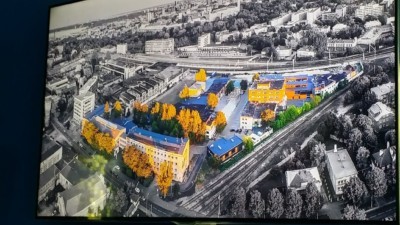
Telliskivi is the remarkable experiment of Jaanus Juus and his team who have turned a “perfectly good industrial wasteland” into a hub of social enterprise – based on soft values as the platform for profit that is widely shared in the community.
I joined Jaanus in his Theatre of 12 Rooms to discuss the success that he has had despite the many naysayers who predicted that soft values would never equate to entrepreneurial success.
But Jaanus and his team have attracted 250 organizations who benefit from substantial rent reductions (up to 50%) because 20 commercial organizations are willing to pay market rates to locate not just at an address but as part of a community. The community is a lively neighbourhood full of restaurants (who are happy to compete with one another because the success of each of them, attracts success for all of them).
The Creative City is enlivened by a variety of social entrepreneurs, a pop-up radio station, free galleries (like the Photo Gallery which had just curated one of Estonia’s most famous photographers Johan Kuus, who documented the untold stories of South Africa’s apartheid era).
The impact of developing a Creative City based on soft values means that Jaanus will be moving his personal residence back to the neighbourhood, which was not safe enough to raise his family, when he first started. Now the neighbourhood demonstrates the positive outcomes of bringing back to the streets, eyes, feet, heads and hearts:
76% say public safety has improved
89% see an improved quality of life
88% of local residents are more active & involved in the community
86% feel more engaged in the evolution of city space
80% report a boost in social wellbeing
98% sense a positive impact on the district’s reputation.
Jaanus is no doubt an unusual entrepreneur – interested in not only redeveloping Tallinn’s industrial infrastructures, but in Europe’s most (fibre optically) connected country and city, he is also the sponsor of entertainment that enlightens. He proudly showed me the potential of the Theatre of 12 Rooms – where each seating pod had an electronic coffee table. This turns out to be a mini-hub for the occupants of each room to participate in interactive plays. The plays each have a purpose driven plot. They are performed live on the stage of the theatre and the audience becomes interactively involved in deciding the outcome of the play. But this is not just a simple binary choice at a single point in the play. Instead in the play about a person’s life from childhood to mature adult there are 64 possible outcomes because of the 8 milestones that are encountered throughout the life.
Another play has the unlikely title “Life of the Tick” and splits the room into 2 sets of 6 rooms who compete with one another to help the character that is the Tick negotiate a series of challenges. A time element comes into completing this theatrical game, that reveals the effectiveness of the teamwork in each of the 2 sets of rooms.
As you might imagine, this unique creation has attracted the attention of some of Europe’s big corporations who have booked the theatre for conferences and executive development. Rumour has it that serious lessons in leadership development were learned by a group who took an hour and a half to solve the Tick’s dilemma – as compared to a group of school girls who solved it in 20 minutes.
Altogether, the visits to Creative City were inspiring and lively. I could see all 5 sets of Integral City Intelligences online and activated by the city’s 4 Voices. I viewed a group of seniors from Denmark working out in a public space. I saw families having a great time on the weekend. I was interviewed in the pop-up radio station. And I enjoyed the most delicious Salade Lyonnaise (at Frenchie’s) that I have ever tasted.
Perhaps, Tallinn’s Creative City has many lessons to share with the Ecovillage at nearby Lilleoru? It strikes me that the foundations are both based on soft values, that are upheld for the good of the whole. As Jaanus notes – soft values are not charity, they are a genuine investment in the wellbeing of the community that improve both quality of life and commercial success. Perhaps, these are glimpses of how the Master Code of Care (for Self/Others/Place/Planet) are being implemented through Integral City Voices, Values and Intelligences and are being translated into an economy full of aliveness, in northern Europe (for the good of the world)?
Enjoy our visit to Estonia from Creative City to Ecovillage with this series of blogs:
Creative City
Integral City Talks on Radio IDA in Tallinn
Tallinn’s Telliskivi, Creative City is Most Popular Uber Destination
Ecovillage
Imagine Integral City Contributing to Urban Ecovillage Design
4 Dimensions of an Ecovillage
Ecovillage Youth and Elders Explore 6 Questions
July 25, 2018
Ecovillage Youth & Elders Explore 6 Questions
One of the tensions most cities face is how to create the conditions for multiple generations to speak together. In an Ecovillage which is at a smaller scale of “human hive” than a city, the generational tensions can seem even more intense, because people are closer together in time and space on an everyday basis.
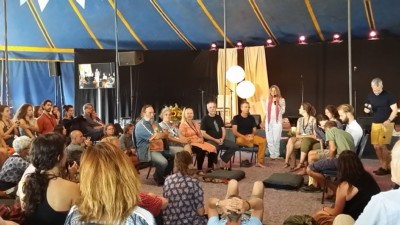
During the Global Ecovillage Network Europe 2018 Conference, The Wisdom of Conscious Communities, a circle of 5 Elders and 5 Youth (from different ecovillages) dialogued about each other’s perspectives and relationships living in an Ecovillage. Each generation alternated with questions and answers. What follows are some of the “call and response” inquiries that emerged, as each generation engaged respectfully but passionately with the inquiry.
Readers should know this report comes from my personal notes as well as my personal interpretations. Some responses may have been combined from several speakers to provide a flow and flavour of the narrative but where possible the sequencing of responses has been retained.
This was one of the most powerful engagements at the conference, demonstrating the Integral City Inquiry and Living Intelligences in dynamic interaction within the contexts of Ecosphere, Individual (Inner and Outer) and Collective (Cultural/Storytelling and Structural/Social) Intelligences.
Marilyn Hamilton, Scribe
Youth / Elder Listening Circle
Youth Question1: What view does your ecovillage have for youth to vision and integrate into your approaches to sustainability?
Elder Responses:
In Damenhur youth and elders work together.
At The Farm we are now 47 years old and have 4 generations living together. We started with a generation of 20 somethings, whose parents noticed their kids had a good thing going – so the parents moved in. That made 2 generations. Then our younger generation had kids and they in turn are now having kids. So, I get to be with my parents, my kids and my grandchildren.
We have a Council of Elders who hold a mature vision. But we also teach meeting skills to young children, so they are facilitating meetings from a very young age.
Elder Question 2: These days it seems difficult to have hope. What keeps you going?
Youth Responses:
I am full of hope.
The old age ended in 2012.
I feel the astrology of the times.
There is post-war healing.
[These days] babies’ eyes seem to be warrior eyes.
I look inside and make a choice.
I am pessimistic but hold on to values.
I have hope in every day actions.
I live next to a forest-system and that system is inside of me.
I don’t want to “dance the last dance on the Titanic”.
Youth Question 3: Is it worth it to start an ecovillage?
Elder Responses:
Our paths are different – always learning.
I never worry – life is fun and interesting and beautiful.
[I ask] how to bring the future into the present?
[Life is] so creative, exciting – I’d never go back.
It’s about the people rather than the place.
It’s like “close encounters of the 3rd kind”.
Find the others who think like you.
It’s exciting to be with people like you.
What else [could I do]? Everything else – is it worth more? No!
It’s a 24-hour workshop.
I started as an individualist in Damenhur, living in community – but I would never go away now [from the collective experience]. It accelerated my pathway to become a Human Being.
It keeps you young – always open to learn.
Elder Question 4: Why is age important?
Youth Responses:
There seems to be a lack of representation without initiation.
Need to find my tribe.
I don’t identify as youth.
We are all in this together. The more we look at years of experience, the more I feel empowered in my community – for other youth to see the issue at last – but who don’t know how to engage.
Youth Question 5: As an older person, how do you engage youth when they are a different age?
Elder Responses:
[I see] different levels [of engagement] – one is personal – where everything is new and can be considered. Then there is interpersonal.
At the community level, in Damenhur the elder chooses a youth to pass on the stories.
In the political structure, youth get results.
Each of us try to be bigger/smarter and we are [altogether] working on the same path.
We talk face-to-face with respect.
We know about each other and help each other.
We empower ourselves.
In my 20’s I would have been insulted to be treated separately. [So, I don’t treat youth any differently than people of other ages/generations.]
[The relationships] need contact. We don’t need distinction between young and old.
It’s a bigger challenge at the community level than at the personal.
Elder/Youth Question 6: What are the most important things you want to learn?
Youth Responses:
The regular school system is out of balance (e.g., in creative subjects and math) – how can we value the topics equally?
How to get along with people? Social Skills, Communication, Working Together?
How to disagree with others so that leads to deeper relationships and supports the community?
People care – healthy relationships.
Shadow, inner ecology.
Decisions/consent.
How can we regenerate a big part of Earth?
Fair share – how can we make this possible?
How to deal with people you don’t get along with?
Leadership – how to be a leader clearly/cleanly?
How do you and your communities work to make space for visions and values that youth bring in?
Elder Responses:
How can we bring in new ideas without losing the essence [of what we stand for]?
How can we work together?
How can an idea shared with many others become a movement (not a mere idea)?
Work-in-Process
Avoid division – seek addition.
Open up the subject.
When things touch you (e.g. story of Africa and Cameroons) stick to values despite the conditions because [we all want] a new humanity.
~~~
Marilyn Hamilton's Blog
- Marilyn Hamilton's profile
- 3 followers


